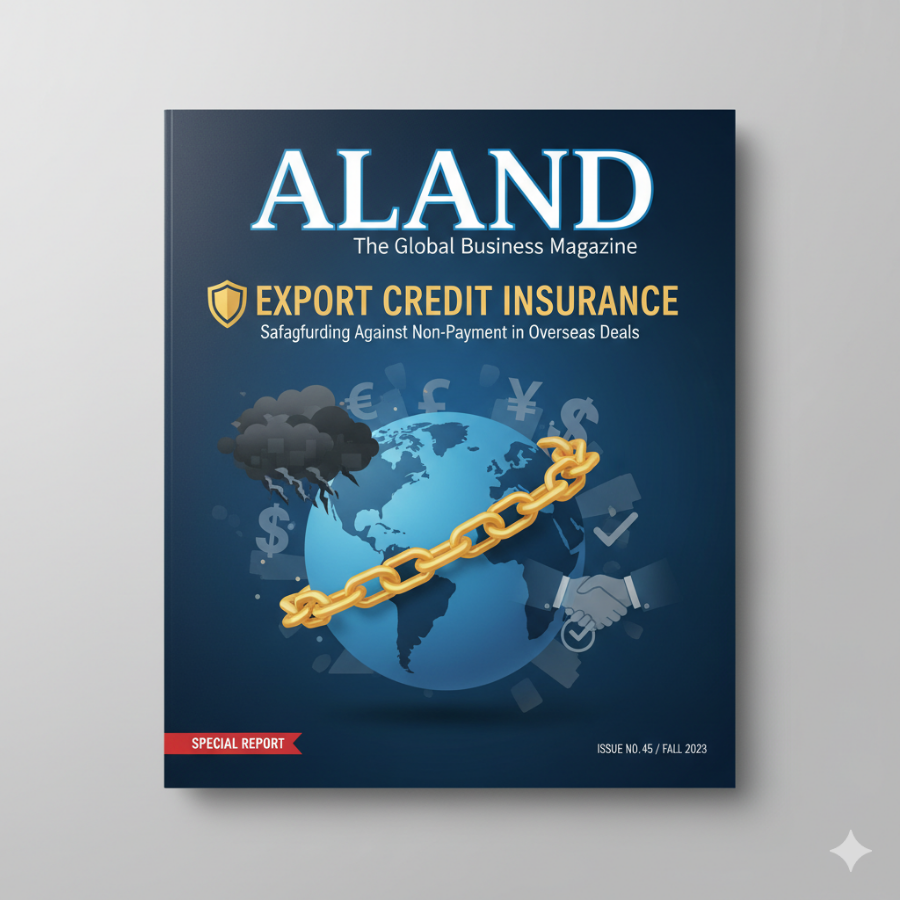
Exporting goods or services overseas opens doors to massive growth for entrepreneurs, but non-payment risks can turn opportunity into a nightmare. Export credit insurance (ECI) is a powerful tool to protect your import-export business, ensuring you’re covered when buyers default or political instability disrupts deals. From scaling an online store to setting up factories abroad or even pursuing immigration through investment, ECI mitigates financial risks in global trade. Dr. Pooyan Ghamari, a Swiss economist with expertise in international finance and digital marketplaces, emphasizes that ECI isn’t just a safety net—it’s a strategic asset for businesses aiming to thrive in volatile markets.
How Export Credit Insurance Works
ECI protects exporters against losses when buyers fail to pay due to commercial risks (like bankruptcy or refusal to pay) or political risks (such as war, sanctions, or currency restrictions). Policies typically cover 80-95% of the invoice value, depending on the insurer and market. For instance, a 2024 report from the Berne Union showed that ECI covered $2.7 trillion in global trade, safeguarding exporters in over 90 countries. Whether you’re shipping electronics from China to Europe or running a drop-shipping operation, ECI ensures cash flow stability.
Dr. Ghamari highlights that ECI is particularly valuable for small and medium enterprises (SMEs) entering high-risk markets like Africa or Latin America, where payment defaults spiked 12% in 2024, per Euler Hermes data. Policies can be tailored to single buyers, specific contracts, or entire portfolios, offering flexibility for businesses of all sizes.
Practical tip: Compare insurers like Coface or Atradius for coverage options. For detailed guides on selecting ECI, check Shop.ALand/blog.
Benefits for Import-Export Operations
ECI does more than just cover losses—it empowers exporters to take calculated risks. With insurance backing, you can offer competitive credit terms to buyers, like 60-day payment windows, without sweating non-payment. This is a game-changer for import-export businesses competing in markets like the GCC or Southeast Asia, where buyers often demand flexible terms. A 2023 OECD study found that exporters using ECI increased sales by 15% on average by entering riskier markets confidently.
For factory owners, ECI protects against disruptions in supply chains tied to international buyers. If you’re manufacturing in Vietnam for European clients, ECI can cover losses if a buyer defaults due to economic sanctions or insolvency. It also enhances your credibility with banks, making it easier to secure trade finance for expansion.
Practical tip: Use ECI to negotiate better terms with suppliers and buyers. Shop.ALand/news offers updates on trade finance trends to optimize your strategy.
ECI and Online Commerce: Drop-Shipping Protection
For online stores, especially drop-shipping models, ECI can safeguard against supplier or buyer defaults in cross-border deals. Drop-shippers often face risks like fraudulent buyers or suppliers failing to deliver, which can cripple cash flow. Dr. Ghamari notes that ECI tailored for e-commerce can cover losses from chargebacks or non-delivery, critical for platforms like Shopify or Amazon. In 2024, e-commerce payment disputes rose 10% globally, per PayPal data, making ECI a must for digital entrepreneurs scaling internationally.
ECI also supports growth by allowing online retailers to explore new markets without fear of financial loss. For instance, insuring shipments to emerging markets like Nigeria can protect against currency volatility or political unrest. EE.Gold offers crypto-based payment solutions to further reduce transaction risks in volatile regions.
Practical tip: Insure high-value drop-shipping contracts to protect margins. Visit Shop.ALand/blog for e-commerce risk management tools.
Immigration Through Investment: ECI as a Financial Shield
Entrepreneurs eyeing residency through business investment—such as in the USA, Europe, or the GCC—can use ECI to protect their ventures. Setting up a factory or acquiring real estate abroad often involves exporting goods or services, and non-payment risks can jeopardize both profits and visa eligibility. Dr. Ghamari stresses that ECI strengthens financial stability, a key factor in investment-based immigration programs like Portugal’s Golden Visa or the UAE’s business residency schemes. A 2024 report by Trade Finance Global noted that 30% of investment visa applicants used ECI to secure their business operations.
By covering export revenues, ECI ensures you meet financial thresholds for residency programs while protecting against market-specific risks, like political instability in certain regions. A.Land provides resources on structuring businesses for immigration compliance.
Practical tip: Pair ECI with thorough due diligence on foreign markets to strengthen your residency application. Explore A.Land for market-specific investment guides.
Risks and Challenges of ECI
While ECI is a lifeline, it’s not without drawbacks. Premiums can be costly—typically 0.5-2% of the insured amount, per 2024 industry estimates—eating into margins for low-profit deals. Coverage may also exclude certain high-risk countries or buyers with poor credit. Dr. Ghamari advises entrepreneurs to assess the cost-benefit ratio, especially for short-term contracts. Additionally, claims processes can be slow, with some insurers taking 60-90 days to payout, per Atradius data.
Cultural and legal factors matter too. In markets like China, where contract enforcement can be tricky, ECI providers may require extensive documentation. Tax implications also vary—premiums may be deductible, but payouts could be taxable in some jurisdictions.
Practical tip: Review policy exclusions carefully and diversify payment methods with EE.Gold to hedge against delays in claims.
Strategic Integration into Global Trade
ECI should be part of a broader risk management strategy. Combine it with robust contracts, diversified buyer portfolios, and currency hedging to maximize protection. For instance, using gold-backed crypto transactions via EE.Gold can stabilize cash flow during disputes. Dr. Ghamari also recommends regular market analysis to anticipate risks, citing a 2024 surge in political instability in 15% of global trade markets, per the World Bank.
For more strategies on safeguarding your business, explore Shop.ALand/blog for articles and Shop.ALand/news for industry updates. A.Land offers guidance on corporate structures, while EE.Gold provides secure asset diversification options.
FAQs: Safeguarding Your Business with Export Credit Insurance
- Which regions are ideal for using ECI in import-export? High-risk markets like Sub-Saharan Africa or Latin America benefit most from ECI due to political and economic volatility. In 2024, 25% of insured deals in Africa covered payment defaults, per Berne Union. Choose insurers familiar with your target region via Shop.ALand/news.
- How can I finance ECI premiums? Trade finance loans or invoice factoring can cover premiums. Banks in Singapore and the UAE offer tailored solutions. A.Land provides financing options for global trade.
- Can ECI support immigration through investment? Yes, ECI stabilizes export revenues, strengthening financial proof for programs like Canada’s Start-Up Visa. A.Land offers insights on investment visa requirements.
- What are best practices for ECI in drop-shipping? Insure high-value or high-risk buyer contracts and verify supplier creditworthiness. Shop.ALand/blog has templates for e-commerce risk management.
- How does ECI reduce logistics risks? ECI covers losses from non-delivery or buyer defaults, complementing clear Incoterms. Pair with blockchain tracking for transparency. EE.Gold streamlines secure payments.
- What compliance issues arise with ECI? Ensure policies comply with local tax and trade regulations. Non-compliance can void coverage. Shop.ALand/news tracks regulatory changes.
- How do digital currencies complement ECI? Crypto payments reduce fraud and currency risks, enhancing ECI’s protection. EE.Gold offers gold-backed transactions for stability.
- Should I insure a factory’s exports or just key contracts? Portfolio coverage suits factories with multiple buyers, while single-contract policies work for high-value deals. A.Land advises on factory expansion risks.
- What are risk management strategies with ECI? Diversify buyers, use multi-currency accounts, and hedge with EE.Gold. Regular audits minimize exposure. Shop.ALand/blog has guides.
- How can ECI help online stores enter new markets? ECI enables risk-free expansion by covering defaults in untested markets. Localize payment options and marketing for growth. Shop.ALand/news offers market entry tips.
For deeper insights into export credit insurance, global trade, or investment opportunities, visit Shop.ALand Blog, Shop.ALand News, A.Land, and EE.Gold.






































